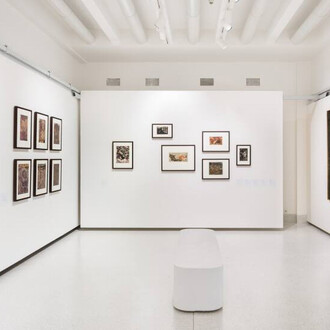Architecture as a costume? Body as a space? Fabric as a volatile skin of a humanoid being? Sara Enrico’s biomorphic structures perform the decaying corporeality of our surrounding by constructing psychosomatic hybrids that reanimate the senses and activate the intensity of physical experience. Her site-specific and quasi-parasitic project in the National Gallery's Presidential Lounge, The Jumpsuit Theme, is the artist’s attempt to negotiate the spatial materiality in-between the painting and the object, in the increasingly grey zone of illusory volume and omnipresent flatness. Sara Enrico focuses on the relation between surface and skin; in her work, body, dress and space collaborate in a process of a translation from a sartorial vision into a sculptural and spatial one.
Enrico's work unfolds an idea of a collapsed form versus the dream of a solidity, keeping in mind the art's ethical vocation. The artist’s cloth paintings and painterly objects mimic the autonomy of meaning and perception, thus foregrounding an intimacy of a substitute and proxy. Her compositions are anti-monuments of corporeality, caught in a post-historic moment of physical exhaustion and decline: pseudo-figurative collages of bodily fragments, damaged skin-like surfaces, piled en masse and abandoned, decomposed memories of grande narratives, fading away in a disciplined age of an auto-correct device. Neo-baroque and futuristic, these are theatricalized versions of a new anthropology for a synthetic world of fake history and amnesia. Enrico reimagines body in a post-human era of surgical experimentation, provoking a thoughtful reflection on the bioethics and the anatomy of morals.
According to Sara Enrico, “the exhibition title The Jumpsuit Theme references the garment of a jumpsuit and the idea of a theme understood as a variation and improvisation on the construction principle, as inspired by the groundbreaking work of the artist Ernesto Michahelles (1893-1959), alias Thayaht, the inventor of the TuTa a T in 1919 and by the stylist Madeleine Vionnet (1876-1975), who initiated fashion revolution which contributed to women’s emancipation.
The Jumpsuit Theme has been conceived in two stages, correlated through a sense of transformation and pause: Camerino at The National Gallery Prague and Intermezzo at MART in Rovereto (Italy). Camerino represents the place of a disguise: here we experience a moment of transformation when a person becomes a character or vice versa. Camerino is a (dreamy) beginning: a fabric starts to be shaped and drawing up a dress. The appearance of a ‘body’ is only hinted through a germinal attempt to generate a three-dimensional shape, modeling sleeves and cutting forms. Some sculptures, made in concrete and with pigments, relate to the fabric installed in the room. They are conceived by simple cylinders used as modules for creating an abstraction of a jumpsuit. The soft suit-formworks, favouring the flow of concrete and containing its expansive forces, have delivered volumes of certain anthropomorphic postures. With Camerino, the spectator enters an intimate place of mutation; as a generative experience, it evokes an indistinct, yet welcoming state.”
Sara Enrico (born 1979 in Biella/Italy; lives and works in Turin) studied at Accademia di Belle Arti in Turin and at the Istituto Spinelli in Florence (faculty of restoration of ancient paintings and frescoes). In 2013, she attended the Advanced Course in Visual Arts with Matt Mullican at the Fondazione Antonio Ratti in Como. She has had residencies at Fondazione Spinola Banna per l’Arte in Poirino with Jason Dodge and Raimundas Malašauskas (2015), and, earlier, at VIR-viafarini-in-residence in Milan (2012). In 2018, Enrico was a recipient of the grant of the IV edition of Italian Council competiton promoted by Directorate-General for Contemporary Art and Architecture and Urban Peripheries (DGAAP). In 2017, she received the New York Prize as artist-in-residence at International Studio & Curatorial Program in New York.
Sara Enrico has exhibited her works in Italy and abroad, including MART - Museo di arte moderna e contemporanea di Trento e Rovereto; Centrale Fies Art Work Space, Dro; Marsèlleria, New York; Fondazione Sandretto Re Rebaudengo, Turin; Les Instants Chavirés, Montreuil; and Fondazione Antonio Ratti, Como, amongst others. She participated in OFF Biennale Cairo, Cairo, 2018 and in Biennale Internazionale Arte in Memoria, Sinagoga, Parco Archeologico di Ostia Antica, Ostia (Rome), 2017.
















